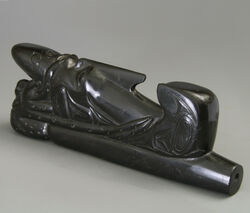Totem pipe of the Haida
November 2022

Argillite is found on Queen Charlotte Island on the west coast of Canada. The word is derived from the French word argille which refers to clay stone and has a high loam content. It is a carbon black stone closely related to slate that cuts well. The stone is mainly found in the quarry at Slatechuck Mountain in the headwaters of the eponymous creek on Graham Island. The Haida carving is one of the few art forms on America's northwest coast that is the exclusive right of one cultural group. The Haida people of this area extract this stone to make carvings for sale to sailors and tourists. These artistic sculptures, including countless tobacco pipes, have been world famous since their creation around 1800. This fame is partly due to the appealing portrayals, in which all kinds of figures in a recognizable stylization. Bears and birds are very popular, we also see countless human depictions. The Haida pipes are mainly so-called panel pipes, flat plates overgrown with figures. In addition, totem poles are made, which have a stronger three-dimensional design with a vertical accent. The present pipe lacks the main features of both species. For example, the flat feature of the panel pipe is missing, neither does the pipe follow the vertical accent of the totem pole. Yet it is a real tobacco pipe with a pipe bowl connected to a smoke tube ending in a mouthpiece, but everything is hidden in the decorations. What is special about this product is that the subjects are executed in various styles that, in terms of arrangement, go back to Picasso rather than the Haida, which makes this pipe so exclusive. We see a stylized fish head and another animal next to human heads or parts thereof, all elements flowingunnoticed from one to the other. The tradition of stone carving continues to this day, but this wondrous creation must have come about around 1900.
Amsterdam Pipe Museum APM 24.603
Permalink